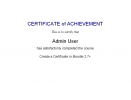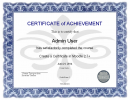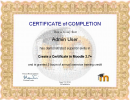Certificate module
| Certificate module | |
|---|---|
| Type | Activity |
| Set | N/A |
| Downloads | https://moodle.org/plugins/view.php?plugin=mod_certificate |
| Issues | http://tracker.moodle.org/browse/CONTRIB-2006 |
| Discussion | https://moodle.org/mod/forum/view.php?id=7163 |
| Maintainer(s) | Mark Nelson |
The Certificate module creates PDF certificates/diplomas for students in a course and can be customized by the certificate settings menu. You can add borders, watermarks, seals, signatures, outcomes, grades and even add custom text.
Certificate should be downloaded from the download Plugins at Moodle.org (see the info box on the page for a link). You should select the certificate download that matches your Moodle version.
Certificate examples
Here are 3 examples. Click on one to enlarge it. A certificate that uses the standard features found in the install package. Then 2 others show different possible ways to customize a certificate.
- Certificate examples - click on any to enlarge
Installing
- Download and Unpack the Certificate zip file (for example mod_certificate_moodle27_2014041800) for the Moodle version your are using in a temporary area,
- Copy the "certificate" folder to your Moodle mod folder located for example at yourhost\moodle\mod . The certificate folder will include folders backup, db, lang, pix (including subfolders for borders, seals, signatures and watermarks), and type (with sub folders for each of 4 default types).
- Go to your Moodle, and click on the Notifications link in the Site administration. Moodle knows something has been added and it will proceed to install the certificate module.
Note: It is not necessary to move the lang file into the Moodle lang folder, the certificate lang folder(s) can stay in the mod/certificate folder. Note: Advance users upgrading from 1.9.9 or installing Certificate for the first time, might consider editing the files in the pix folder before installing via the notification link. These will be used as the default file. Site administrators can upload more images via the interface after installing the module.
See also: Installing_contributed_modules_or_plugins in MoodleDocs.
Settings
This is a short list of settings listed by their group. Please see Add/edit_certificate_module for more detailed information.
- General - Certificate name and introduction. The certificate will use the course name, this is the link name.
- Issue options -Here you can set email options, determine if you want to save and how user views the certificate. You can set minimium time the user must be in the course before issuing the certificate.
- Text options - determine date, security code, grade outcomes, credit hours, teachers names, custom text.
- Design (and image) options - select certificate type/print orientation, select images for border, lines, watermark, signature, seal or say no to any or all of these options.
- Common module settings -These are standard Moodle module settings. See Common module settings
- Locking options - if conditional dependencies has been turned on by the site administrator, teacher can set standards that must be met before certificate can be issued.
Customizing certificate
There are several ways to create a custom certificate. Please see Certificate customizing for many examples and code hints. A few quick examples from easiest to more skilled required:
- Add your own images via the site administration>Plugins>Activities>Certificate in the appropriate type. Types are boarders, seals, signatures and watermarks.
- Add your images to the appropriate /mod/certificate/pix folder. This will also make them available under settings.
- Edit the text strings in the /mod/certificate/lang folder files, or though the customize language tool available to site administrators.
- You may create as many "types" of certificates as you wish. This is more complicated and requires some knowledge of PHP and of course access to the moodle/mod/certificate folder.
Certificate companions
This page requires updating. Please do so and remove this template when finished.
Not all these may work with Moodle 2.x.
Certificate Site-wide Report
As of February 2008, there is a Certificate Site-wide Report which can be added in Moodle 1.9, as a supplement. This is an add-on to the certificate module--if installed, you will have an option when creating a certificate to send that certificate's info to the report. An optional block is included that provides a link to the report. Students will see a list of all received certificates. Administrators (or those who have the capability of viewing site reports) will see a link on the Certificate Report page to view/download a report of all students' received certificates. To install: Place the certificates folder in your root (main) moodle folder and upload to your server. Place the my_certificates block folder under your moodle/blocks folder, upload to your server and click on the Administration>>Notifications link to install.
Certificate Verification Block
A companion to the Certificate module for Moodle 1.9. This is a block with a form for entering a given certificate code for verification. The verification page shows the student name, course name, date received and grade (if a grade is printed on the certificate). The certificate code can be printed on a certificate.
This feature is useful when a Registrar, supervisor or administrator wishes to verify that the printed certificate is valid for that student. To install: Place the verify_certificate block folder under your moodle/blocks folder, upload to your server and click on the Administration>>Notifications link to install.
In Certificate for 2.x, the view certificates will show the student name, date received, grade and code. These are downloadable via several file types.
See also
- Add/edit certificate module
- Viewing a Certificate
- Certificate customizing - many tips and how to make changes to code to customize certificates even more.
- Using Moodle Certificate module forum
- Conditional activities - When this site feature is turned on, teachers can set conditions based upon other activities in the course before a certificate will be issued.
- Development of the certificate module
- Patch to enable linking to Face-to-Face contributed module.



